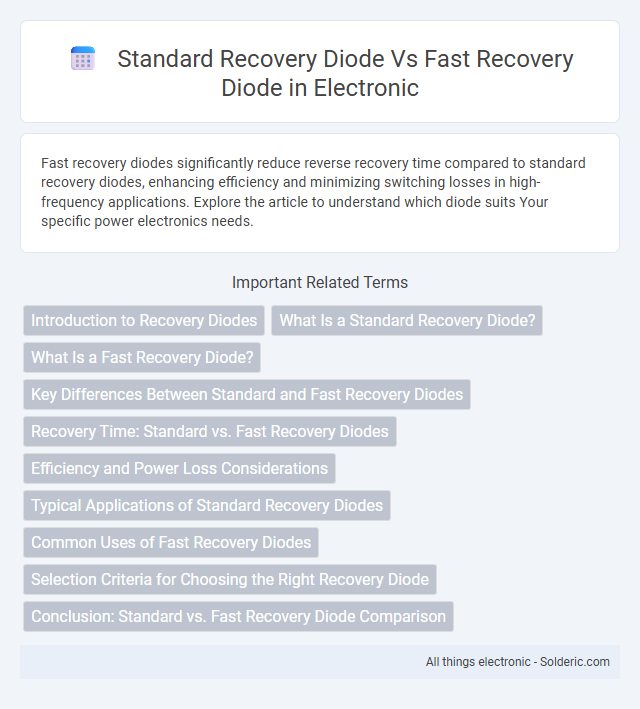Fast recovery diodes significantly reduce reverse recovery time compared to standard recovery diodes, enhancing efficiency and minimizing switching losses in high-frequency applications. Explore the article to understand which diode suits Your specific power electronics needs.
Comparison Table
| Feature | Standard Recovery Diode | Fast Recovery Diode |
|---|---|---|
| Recovery Time | Typical: 2-5 us | Typical: 50-500 ns |
| Reverse Recovery Charge (Qrr) | Higher | Lower |
| Switching Speed | Slow | Fast |
| Switching Loss | Higher | Lower |
| Application | Power rectification in low-frequency circuits | High-frequency converters, switching power supplies |
| Cost | Lower | Higher |
| Thermal Performance | Better at low switching frequencies | Better for high-speed switching |
Introduction to Recovery Diodes
Recovery diodes play a crucial role in power electronic circuits by efficiently managing the transition from conducting to blocking states, minimizing energy loss and heat generation. Standard recovery diodes feature longer reverse recovery times, making them suitable for low-frequency applications, while fast recovery diodes offer significantly reduced reverse recovery times, enhancing performance in high-speed switching. Understanding your circuit's switching speed and efficiency requirements is essential when choosing between these diode types.
What Is a Standard Recovery Diode?
A standard recovery diode is a semiconductor device designed to block reverse current flow after conducting in the forward direction, with a relatively slower reverse recovery time compared to fast recovery diodes. This slower recovery time makes it suitable for applications where switching speed is not critical, such as power rectification in low-frequency circuits. You should choose a standard recovery diode when efficiency in high-speed switching is less important than cost and reliability.
What Is a Fast Recovery Diode?
A fast recovery diode is designed to switch off more quickly than a standard recovery diode, reducing the reverse recovery time and minimizing power loss in high-speed switching applications. Its rapid transition from conducting to blocking state makes it ideal for use in switch-mode power supplies, inverters, and other circuits requiring efficient high-frequency performance. Choosing a fast recovery diode can significantly improve your circuit's efficiency by reducing switching losses and electromagnetic interference.
Key Differences Between Standard and Fast Recovery Diodes
Standard recovery diodes feature slower reverse recovery times, typically in the microsecond range, making them suitable for low-frequency applications where switching speed is not critical. Fast recovery diodes offer significantly reduced reverse recovery times, often in the nanosecond to sub-microsecond range, which minimizes switching losses and electromagnetic interference in high-frequency circuits. Your choice between these diodes impacts overall circuit efficiency, especially in power electronics and switching power supplies demanding rapid response and lower energy dissipation.
Recovery Time: Standard vs. Fast Recovery Diodes
Standard recovery diodes typically exhibit longer recovery times, often in the microseconds range, causing higher switching losses and slower response in high-frequency applications. Fast recovery diodes reduce recovery time significantly, usually to a few nanoseconds or tens of nanoseconds, enabling more efficient switching and reduced electromagnetic interference in circuits. Choosing a fast recovery diode can enhance Your system's performance, especially in power electronics and high-speed switching environments.
Efficiency and Power Loss Considerations
Standard recovery diodes exhibit higher reverse recovery time, leading to increased power loss and reduced efficiency in high-frequency applications. Fast recovery diodes minimize reverse recovery time, significantly reducing switching losses and enhancing overall circuit efficiency in power electronics. Selecting fast recovery diodes is critical for optimizing efficiency and minimizing thermal stress in converters and inverters.
Typical Applications of Standard Recovery Diodes
Standard recovery diodes are commonly used in power rectification for low-frequency applications such as power supplies, battery chargers, and lighting ballasts, where switching speed is less critical. Their slower recovery time reduces electromagnetic interference in circuits operating at moderate switching frequencies. You benefit from their robustness and cost-effectiveness when designing circuits that prioritize reliability over high-speed switching performance.
Common Uses of Fast Recovery Diodes
Fast recovery diodes are commonly used in high-frequency switching power supplies, inverters, and motor control circuits where rapid switching and minimal reverse recovery time are crucial. They are ideal for applications requiring efficient energy conversion and low switching losses, such as in SMPS (switched-mode power supplies) and active power factor correction circuits. Standard recovery diodes, by contrast, are typically employed in low-frequency rectification where switching speed is less critical.
Selection Criteria for Choosing the Right Recovery Diode
When selecting a recovery diode, consider the switching speed and application frequency; fast recovery diodes are ideal for high-frequency circuits due to their shorter reverse recovery time, minimizing switching losses and electromagnetic interference. Standard recovery diodes suit low-frequency, high-current applications where slower recovery time and higher reverse recovery charge are acceptable. Your choice depends on balancing efficiency, thermal performance, and cost, ensuring the diode matches your circuit's transient response requirements.
Conclusion: Standard vs. Fast Recovery Diode Comparison
Standard recovery diodes exhibit longer reverse recovery times, making them suitable for low-frequency or less sensitive applications due to lower switching losses and cost efficiency. Fast recovery diodes offer significantly reduced reverse recovery times, enhancing performance in high-frequency circuits by minimizing voltage spikes and improving overall efficiency. Your choice depends on application speed requirements and efficiency priorities, with fast recovery diodes favored for rapid switching environments and standard diodes for durability and economy.
Standard recovery diode vs Fast recovery diode Infographic

 solderic.com
solderic.com